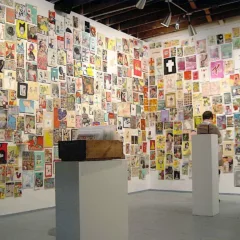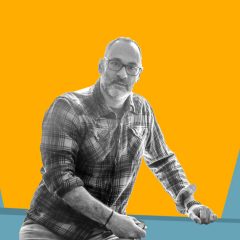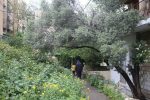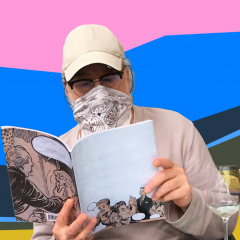In 1998 I met the German artist Gloria Zein in Paris. We were on the street near my house in the 14th arrondissement. She handed me a postcard. It was a cross between a BYOA (Bring Your Own Artwork) and dinner at her house in Paris: one had to cut a circle out of her card and insert a “sign of our existence” into it – an assignment with tape, staples or whatever was handy. Since then I have been following Gloria’s career with wonder. In 2002 she asked her male friends to send her photographs from the Internet of their “dream” girl; this was Foreplay (Vorspiel(e)). Gloria worked out, dressed up, had herself photographed in various (sometimes sexy) poses and produced enormous portraits of herself as little girl, ghost, hooker, dream. Some years later she posed as social furniture in a collector’s home, and after that she did a project where she interviewed philosophers to determine their concepts of individual positioning, connectedness and reality and then went about designing a bed for each of them; the works were shown in Berlin, New Haven and Tehran. Now the mid-career artist, having completed a Masters degree at Chelsea College of Art in London, has entered into a new phase of her work that is larger, more public and yet still is both private and intimate.
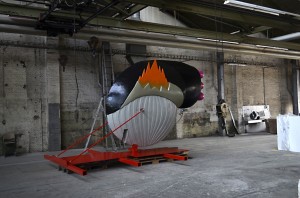
Our discussions have always been expansive and while never addressing the question directly, we’ve always dabbled in the question of German and/or American and/or French art. We touch upon it in the discussion below, sometimes obliquely, sometimes with a grin. This interview is not conclusive, but with the installation of Zein’s work at the Goethe-Institut on Exhibition Road in London – inside and out – it’s hard to ignore this German artist who speaks four languages and lives in an increasingly networked world. All this in spite of the fact that she has a penchant for creating both quiet conceptual works and quite loud in-your-face monumental sculptures. The interview that follows was conducted via e mail and a bit of telephone.
Matthew Rose: You have worked in architecture for two decades and your art has always had a conceptual slant. But at the Goethe-Institut in London (the German Cultural Institute), you have brought together a rich and detailed investigation of architecture with a full on conceptual approach that is loaded with content. You’ve remade the stairwell, recast the employee work areas with sculptures, and re-imagined the entire back façade of the building. And that with a sculpture the size of an elephant that is both friendly and strange and now dominates the park behind the building on Exhibition Road. That’s a pretty strange trip – from small social interactive pieces in your apartment in Paris to public sculpture in London! How did you get from there to here?
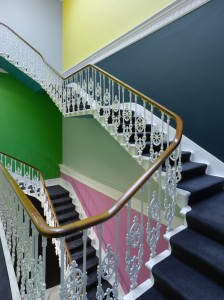
Gloria Zein: I’ve been exploring a participatory approach to art making for quite a while. For the Goethe-Institut project I interviewed every employee, from the receptionist, the librarian and cleaning staff to the German teachers, the cultural department workers and the director to understand the structure of the Institute before designing and dedicating a small sculpture for each function.
This Goethe-Institut commission came at a perfect time, as it allowed me to closely weave these interests with my sculptural practice: The building is not a gallery, not a white cube, but serves as a five-floor office building. I decided to make this constraint the center of my work. Thus the intensive encounter with the architecture.
And, you are right: Throughout the past 15 years my projects have grown in size and complexity. I think this happened quite naturally. Curiously, my architectural background was responsible for the early conceptual take. When I became increasingly involved with sculptural and spatial concerns, my technical skills of imagining, planning and conceiving large pieces certainly helped. What is more, I cannot be indifferent to space: Every object, and thus every sculpture, changes according to the environment it is exposed to.
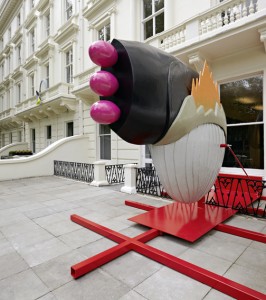
Matthew: How do the sculptures on the terrace relate to your social concerns?
Gloria: They came out of the idea of international communication, which is an important element of the Goethe Institute’s understanding of itself as an institution in London. I figured that anything placed outside the building would automatically be interpreted as “German culture.” By the same token, I am referred to as a “German artist” – but, really, what does that mean? Like many contemporary artists, I received my professional education and training in a handful of countries, and I have lived almost half of my life abroad – outside of Germany. My grandmother was Spanish, my father born and raised in Spain. What makes me, other than my passport, a “German artist?” I was interested to take aim at the perception of that thing called “German art.”
Matthew: Is your work German? What do you share with Gerhardt Richter, Neo Rauch, A.R. Penck, Georg Baselitz, Sigmar Polke … Is Gloria Zein a German artist?
Gloria: Attempting to answer the question of what is “German Art” would be like labeling a work Male Art as opposed to Female Art. Which criteria could be applied for such categorization? The country of upbringing? The type and place of professional training? The artist’s references? The subject matter (if there is any)? Statistics? Or merely genetics? Thankfully, the Goethe Institute supports a range of cultural debates currently held in Germany – whatever the implied artists’, writers’, philosophers’ or musicians’ background or nationality might be.
I believe that each of the artists you mentioned is internationally highly respected, even though Richter is probably monetarily more valued. They are all first and foremost painters belonging to a different generation than me. Theyemerged in historically significant years with work referring to politics and social life in Germany post-WWII, which made them easily associated with Germany.
Beyond that, what does it mean to lump together Richter’s vast and elegant oeuvre, Penck’s somewhat archaic sign system and Rauch’s digestion of socialist painting and billboard tradition?
I am neither a painter nor do I explicitly deal with German history. I am much more a child of the globalized world with all of its implications: the boundless possibilities of communication, image and money flow; expanding mobility and mass migration; overpopulation; diminishing resources, globally operating corporate land-grab – and the new issues of belonging and identity that come along.
To get back to your artist list: I do appreciate the humor in Polke’s work! But then, the same counts for Franz West, who’s radical sculptural practice is more relevant for my own – regardless that fact that, as far as I know, he held an Austrian passport.
Matthew: So you don’t see your art work as a particular flavor of “German?”
When we look at the long history of human migration and the relatively young concept of nations, there seems to be a certain arbitrariness in how borders have been formed and drawn, and the sense of identification that comes along with them. The sculptures on the terrace deal with this uneasiness of national representation. Especially the large one, which looks very different depending on how its approached – up close, from a distance, from the side: It’s not only “friendly” but also inappropriate: From the side, it looks a bit like a pistol, and the thing is somehow sexual, and its construction speaks at the same time about motion and confinement… I think, the more time you spend with it, the more these contradictory aspects about it unfold.
Matthew: Yes! The work does have an oblique sexual sense to it – in a cartoon way. It is as if it were a model of some reproductive organ we’ve yet to encounter, but its size is one of the things that makes it friendly in spite of the fact that it echoes the shape of a pistol. Buy it’s too big to scare anyone and its colors seem drawn from Disney or a high school biology book. You mentioned that children love it, even in its abstract-ness. What’s curious about this piece – because it is abstract with representational leanings – is that it doesn’t declare itself to be something in particular but it is so self-assured of itself, it’s quite definite. Tell us about the concept of the piece and how you built it from its drawing phase to its final installation in London.
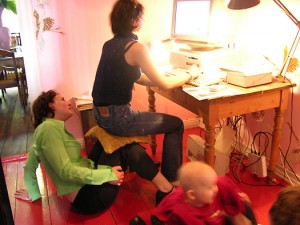
Gloria: I had rather an idea of what I was trying to achieve than a precise concept: With its depth of eight meters, the terrace looks like a stage having an impressive historic façade as a backdrop. I wanted to reinforce this notion with sculptures that would recall the artificiality of two-dimensional props. So I played with a selection of previously made crayon drawings that I placed inside my maquette. These drawings are an important part of my creative process, as they allow me to develop objects or abstract characters quite autonomously and in an unconstrained way. When I start a new drawing, I let myself be guided by the line and by what happens on the paper. By embracing accidents and chance, new forms can emerge. At this stage, I don’t think about an exact form, shape, representation or about technical feasibility. When I’ve approved a drawing and decided that I want to see it as a three-dimensional object, I start to define the thing – including its material, size and exact shape. That’s how the sculptures for the terrace and balcony came to life.
Matthew: So once you’ve produced a flat, crayon drawing of the piece, how did you decide on the final shape and form and the size and the color scheme? Scaling it up and then determining the materials? It’s not a simple thing – it’s a museum piece. So all that activity involved in building these pieces are focused on the destination or the architecture…?
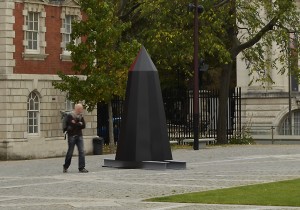
Gloria: I’ve developed the two sculptures in response to the monumental architecture on Exhibition Road. I didn’t want the work to blend in, but to create the largest possible contrast in order to establish a pronounced dialogue between the building and its sculptural visitors. My commission for the Institute is a temporary intervention: Just like a theatrical performance it activates the historical architecture.
The large sculpture found its place behind the window opposite the building’s main entrance, where it extends the axis between Exhibition Road and the Park. It becomes the counterpart of the main stairwell’s vertical axis. The sculpture’s pill-shaped belly and its red plinth further stress this spatial dynamic. The juxtaposition of this slick and almost industrial steel structure and the rather organic, painterly quality of the upper part also came about during the working process.
The final form of the sculpture on the balcony derives from its interplay with the sculpted balustrade. The segmentation of the original drawing into three elements led to an animation of the work. Curiously, the council rated this sculpture too disturbing for the overall aspect of the listed building and allowed us to display it for one month only. We have now asked for permission to install the work on the terrace in a radically different composition, which I am quite exited about. The piece is called “Set” because of this modular aspect.
As for the choice of colors, the work itself asked for specific tones, which I mostly defined in the maquette phase. Though derived from free forms, the sculptures turned out very determined, and the choice of colors acknowledges that. They look like they know what they are doing. Nevertheless, it’s fascinating and at times even disturbing to observe how the full-scale sculpture’s character is built during the painting process: The primed Styrofoam pieces are white, a bit like marble, and the piece appears to lose its innocence through the application of color.
Matthew: So did you put on some kind of high-tech suit to carve the Styrofoam? Had you ever worked with that before?
Gloria: Until recently I used to work in the traditionally architectural fashion of assembly and construction. I have only started to get interested in Styrofoam and in carving during the course of this project. For some of the small works in the offices I have combined these two methods and am enthused by this sculptural avenue. And to answer to your first question: Yes, we wore high-security super sealing pink working suits to prevent the statically charged Styrofoam particles from tacking to our t-shirts and hair…. we looked very cool.
Matthew: Getting a mammoth sculpture from Berlin to London is in itself monumental. I mean Larry Gagosian didn’t help you, nor did NATO. Tell me about the process of building the pieces in Berlin and then transporting them to Exhibition Road, a busy busy location right in the middle of London.
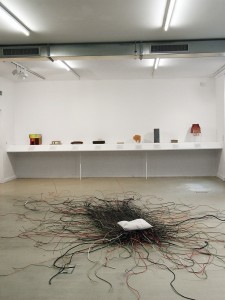
Gloria: I was very fortunate to work with two fantastic teams in Berlin. Sculptureberlin, run by three artists, helped me to produce the Styrofoam carvings planked with fiberglass. Bernd Euler fabricated the steel plinth and interior gallows. We test-joined everything at Sculptureberlin’s workshop, where I also painted the pieces. For transportation and installation purposes, the large sculpture is an assembly of nine elements!
When the truck left Berlin, it looked like the relocation of a weird fun fair, an abstract circus! I very much enjoyed that moment watching it roll away down the streets of Berlin. The situation in London was a bit tricky, as everything had to be hoisted above a stone railing. But the installation team was extremely canny. They had done a test-run in Canterbury, where the company is based. Upon arrival in London via ferry, they unloaded and installed the sculpture on the terrace within a few hours, and I set up the work on the balcony the same afternoon.
Matthew: Did your small sculptures for the offices and work areas also start off from drawings?
Gloria: No, they resulted from an investigation and experimentation with different materials and found objects. In a way, this process relies as much on trial, error and accidents as the crayon drawings do, but here I immediately worked with the physicality of the material, such as metal, cardboard, latex, rubber, tape – and Styrofoam. When I develop these works and imagine their fixtures, it’s like drawing in space…
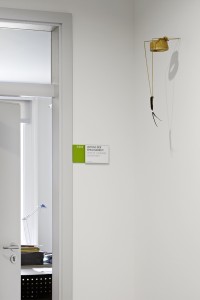
Matthew: Some of your earlier artwork has been linked to architecture and your interest in conceptual art and philosophy. I remember in particular when you offered yourself as a piece of furniture in a collector’s home in Berlin, your interviews with philosophers and subsequent drawings and models of their beds which you produced for the US exhibition about confinement. Can you explain how your interest in space translates into content for these works?
Gloria: For me, these projects do not at all relate to architecture, but to the human body from a philosophical and aesthetic point of view. I am fundamentally interested in asking questions about the artist and society.
In this respect, an important link between these projects is the involvement of people outside the art world, beyond the “art context.” As opposed to the philosophers’ beds, which where shown in gallery settings, the present commission allowed me to expand the social notion of my work into space: Following interviews with staff members at the Goethe Institute, I installed 30 small-scale sculptures spread around the entire building – one for every department and field of activity, including the janitorial workroom! A specific use of materials, fixing methods and symbolic fragments enabled me to imagine a lurking network of secret relationships. This spatial intervention feeds back into the Institute’s social network, as the interviewees now wander around the building investigating each others’ objects and professional functions.
My interventions for the stairwell and terrace at the same time work with and comment on the spaces where they are located. I painted the walls and ceilings of the historic stairwell on five floors in 27 different colors determined by a throw of dice. Although the work is highly seductive, the introduction of chance subverts the traditional idea of iconography and the representative role of the artist and architect, while the sculptures for the terrace – playing with notions of kitsch and monumentality – usurp the idea of a corporate identity. Together, all of these works relate to the building and allowed me to explore ideas about inside and outside, inclusion and exclusion, and disclosure and discretion.
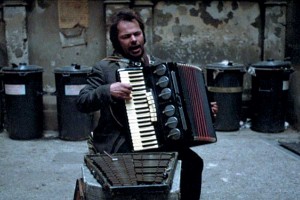
By the way, the exhibition’s title “I Can’t Stop The Dancing Chicken” stems from the question of the artist’s role in society. The “dancing chicken” is the final scene in Werner Herzog’s Film Stroszek. As a Berlin street musician, Stroszek is pushed around on all levels of society. He leaves Berlin, moves to Wisconsin and doesn’t fare much better; at the film’s end, having lost all of his belongings and his love, he calmly walks into an abandoned fun house where he spends his last coin on a tap dancing chicken before shooting himself. While his car is burning nearby, we see the chicken continue to dance compulsively, leading the sheriff to call his boss for help, as he “can’t stop the dancing chicken.” This scene, as well as the entire film, is of an almost unbearable, beautiful absurdity. It asks if artists are doomed to end up as a solitary chicken, dancing manically in a window box for money…
Matthew: Can you tell me why you decided to go to Chelsea College of Art in London and then, once there, how that changed your art practice? Were the teachers good? The students interesting? The programs challenging? Where did it take you in terms of your artwork? More professional? More conceptual? More formal?
Gloria: I decided a few years ago to go back to a university to re-evaluate my art practice because I felt that my rather conceptually-driven approach became problematic. For years, I had followed LeWitt’s postulate of relying on the idea, thus making all of the planning and decisions beforehand, and treating the work’s execution as a corollary. It made the artistic process into a monotonous and dry affair. At Chelsea, I allowed myself to be much more playful: Probing notions of control and chance within the artistic process, I now combine my research with material based practice in the studio. This linkage allows me to process the research’s essential content, make it accessible for sculptural exploration and to develop the concept for a new presentation. So, for me Chelsea with its interesting, eclectic mix of tutors and students, was a great experience at the perfect time.
Matthew: You mentioned that the commission for the Goethe-Institut is a temporary exhibition that will be on view until April 2013. What will happen to the work afterwards?
Gloria: The Institute owns the mural in the stairwell and the small sculptures in the offices. They could take it all down and paint the stairwell back to white next summer. But my guess is, that they might keep the work a bit longer, as the staff enjoys it. The outdoor sculptures are mine and I am quite looking forward to introduce them into new locations to explore how different contexts will shift their identity.
Matthew: If a fairy godmother offered you three wishes, where would you ideally like the sculptures travel?
Gloria: Well, how about this … 1) The Arsenale as part of the Venice Biennale…2) A small, disused store in a derelict city centre… 3) The roof terrace of Corbusier’s Villa Savoye on the outskirts of Paris – provided, of course, that my fairy godmother pays for the shipping!
Gloria Zein’s “I Can’t Stop The Dancing Chicken” continues on view through 2012 at the Goethe-Institut 50 Princes Gate Exhibition Road London, SW7 2PH England UK. More information about the artist’s work and future projects is available on her website: http://www.gloria-zein.com/


